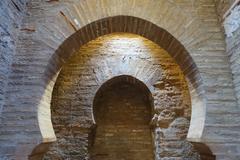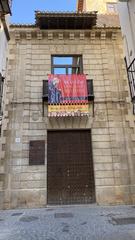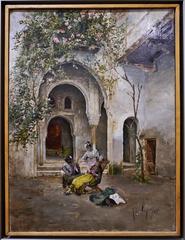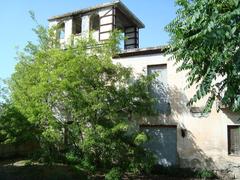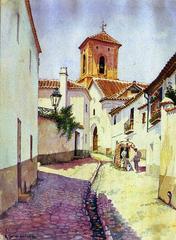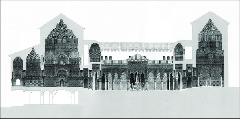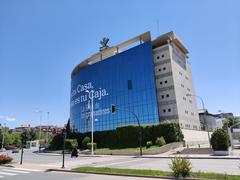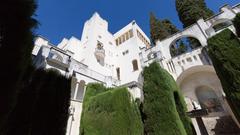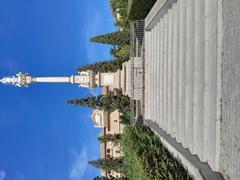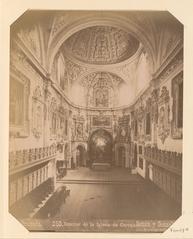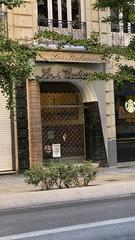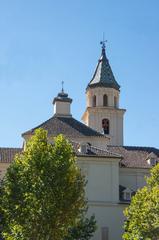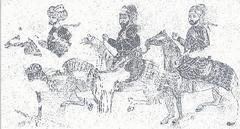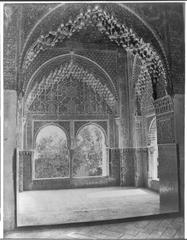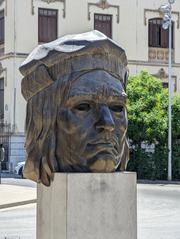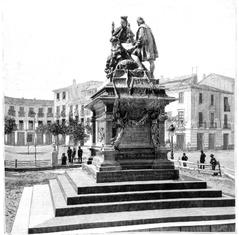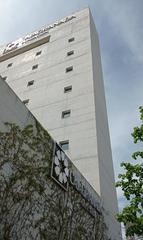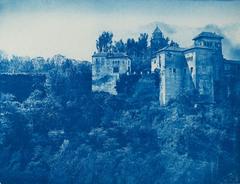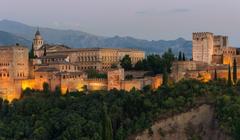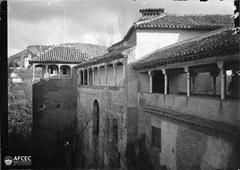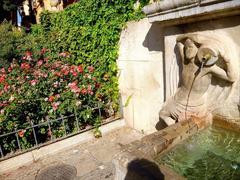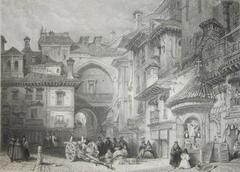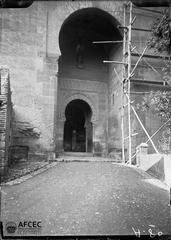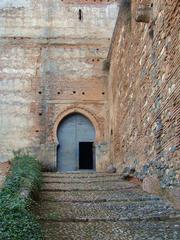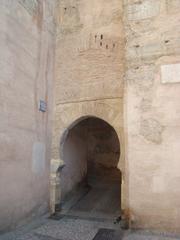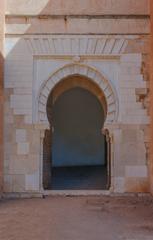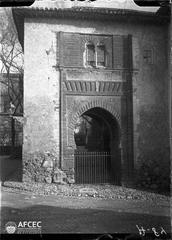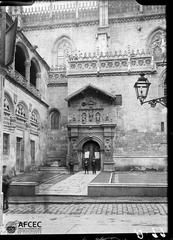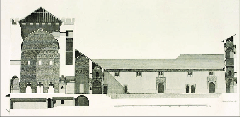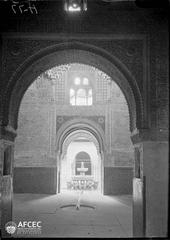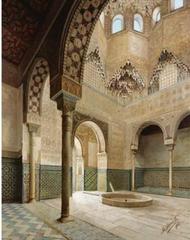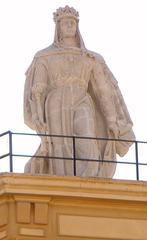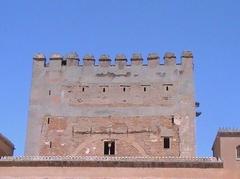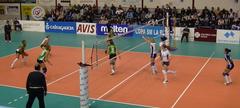Casa Molino de Ángel Ganivet Visiting Hours Tickets and Historical Sites in Granada
Date: 14/06/2025
Introduction to Casa Molino de Ángel Ganivet and its significance in Granada
Casa Molino de Ángel Ganivet stands as a remarkable cultural landmark nestled in the historic Realejo district of Granada, Spain. Originally functioning as a medieval water mill powered by the Genil River’s Gorda irrigation channel, this site embodies centuries of Granada’s industrial ingenuity and agrarian heritage. Beyond its physical structure, the house is deeply intertwined with the life and legacy of Ángel Ganivet García (1865–1898), a seminal figure of Spain’s Generation of ’98, whose formative years in this residence profoundly shaped his literary contributions and intellectual outlook. The Casa Molino’s rich architectural features—including preserved mill machinery and medieval stonework—offer visitors an authentic glimpse into the technological practices of Granada’s pre-industrial era.
Since ceasing mill operations in 1925, the building has undergone thoughtful restoration and adaptive reuse, transforming it into the Provincial Documentation Centre and a vibrant cultural hub. It now serves as a repository of local heritage, showcasing ethnological collections, archival materials, and dynamic exhibitions that celebrate Granada’s multifaceted history. Notably, the current exhibition “Feliz Encuentro. Poesía e ilustración en la colección del Príncipe Preguntón” highlights the intersection of poetry and visual art, engaging families and young audiences through interactive programs and workshops.
Visitors can explore a wide range of cultural offerings, from guided tours illuminating the site’s literary and industrial past to inclusive workshops that foster artistic sensibility and environmental awareness. The Casa Molino is fully accessible and conveniently located near prominent Granada attractions such as the Alhambra and Albaicín neighborhood, making it an essential destination for history enthusiasts, literature lovers, and culturally curious travelers alike.
This comprehensive guide provides detailed information on visiting hours, admission policies, accessibility, and recommended nearby sites. It also outlines the Casa Molino’s educational initiatives and special events, ensuring an enriching and memorable experience. For further details and up-to-date visitor information, consult the official Granada tourism platforms and Andalucia360Travel or Granada Hoy.
Overview History Visiting Hours Tickets Guided Tours Nearby Attractions Accessibility Travel Tips FAQ
- Introduction
- Historical Background and Architectural Significance
- Origins as a Medieval Mill
- Architectural Evolution and Restoration
- Literary and Cultural Legacy
- Connection to Ángel Ganivet
- Role within Granada’s Intellectual History
- Museum Spaces and Exhibitions
- Permanent Collections
- Temporary Exhibitions
- Current Highlight: “Feliz Encuentro” Exhibition
- Educational Programs and Workshops
- Family and School Workshops
- Inclusive and Sensory Activities
- Professional Artistic Encounters
- Cultural Events and Special Programs
- Outdoor Cinema Series
- Heritage Walks and Talks
- Visitor Information
- Visiting Hours
- Tickets and Admission
- Accessibility
- How to Get There
- Nearby Attractions and Travel Tips
- Frequently Asked Questions (FAQ)
- Conclusion
Origins as a Medieval Mill
Casa Molino de Ángel Ganivet, located in Granada, Spain, traces its origins to the medieval period, when it functioned as a water mill. The mill was strategically positioned next to the Genil River, utilizing the Gorda irrigation channel—a vital waterway that powered numerous mills in the region during the Middle Ages. These mills were essential to Granada’s agrarian economy, grinding grain for local consumption and trade. The structure’s robust stonework and preserved mill elements are a testament to its original function and the technological ingenuity of the era (Andalucia360Travel).
The mill operated continuously for centuries, adapting to the changing needs of Granada’s population. Its proximity to the Paseo de la Bomba and the Cuesta de los Molinos made it a recognizable landmark for locals and travelers alike. The mill remained in operation until 1925, marking the end of its industrial use and the beginning of its transformation into a site of cultural and historical significance.
Connection to Ángel Ganivet
The house is most famously associated with Ángel Ganivet García (1865–1898), a prominent writer, essayist, and diplomat from Granada. Ganivet spent his formative years in this house, and the environment profoundly influenced his literary output. His works, which include “Idearium español” and “Granada la bella,” reflect a deep connection to Granada’s landscape, traditions, and intellectual currents. The house is often cited as a source of inspiration for Ganivet, shaping his worldview and literary voice (Andalucia360Travel).
Ganivet’s legacy is intertwined with the Generation of ’98, a group of Spanish writers and thinkers who responded to the social and political crises of late 19th-century Spain. His early death at the age of 33 did not diminish his impact; instead, his childhood home became a symbol of Granada’s contribution to Spanish intellectual history.
Architectural Evolution and Restoration
After ceasing mill operations in 1925, the building underwent several transformations. In 1965, it was renovated to preserve its historical character and adapt it for new uses. The restoration efforts focused on maintaining the original mill mechanisms and architectural features, such as the stone walls, wooden beams, and water channels, which are still visible today.
In 1995, the house was further rehabilitated and repurposed as the Provincial Documentation Centre. This adaptive reuse not only preserved the building’s historical integrity but also gave it a new role as a repository of local heritage. The restoration was guided by principles of conservation, ensuring that visitors can still observe the authentic elements of the medieval mill while engaging with contemporary exhibitions and collections (Andalucia360Travel).
Role as a Provincial Documentation Centre
Today, Casa Molino de Ángel Ganivet serves as a Provincial Documentation Centre, housing a significant collection of publications from the Provincial Council and various municipalities. The centre also features a specialized collection on ethnology and heritage, offering insights into the cultural and social history of Granada and its surrounding regions.
The documentation centre plays a crucial role in preserving and disseminating knowledge about Granada’s past, making it an invaluable resource for researchers, students, and visitors interested in the city’s evolution. The integration of historical artifacts, archival materials, and interpretive displays allows for a multifaceted exploration of Granada’s heritage (Andalucia360Travel).
Preservation of Mill Elements
One of the most distinctive aspects of Casa Molino de Ángel Ganivet is the preservation of its original mill components. Visitors can observe the remnants of the water-driven machinery, including millstones, gears, and channels that once harnessed the power of the Genil River. These elements provide a tangible link to the building’s industrial past and illustrate the technological advancements of medieval Granada.
The careful conservation of these features enhances the educational value of the site, allowing visitors to appreciate the ingenuity of historical milling techniques and their significance in the daily life of the city. The juxtaposition of industrial heritage with literary and cultural history makes the house a unique destination within Granada’s museum landscape (Andalucia360Travel).
Historical Context within Granada
Casa Molino de Ángel Ganivet is situated in a historically rich area of Granada, near the Paseo de la Bomba and the Genil River. This location was once part of the Huerta de San Vicente, an agricultural zone that played a vital role in the city’s sustenance and development. The mill’s operation was closely linked to the broader network of irrigation and agriculture that defined Granada’s landscape for centuries.
The house’s transformation from a working mill to a cultural institution mirrors the broader shifts in Granada’s urban and social fabric. As the city expanded and modernized, many traditional structures were repurposed to serve new functions, reflecting a commitment to preserving heritage while adapting to contemporary needs (Andalucia360Travel).
Significance in Granada’s Cultural Heritage
Casa Molino de Ángel Ganivet stands as a symbol of Granada’s layered history, embodying the intersection of industrial, literary, and civic traditions. Its association with Ángel Ganivet elevates its status as a site of intellectual and cultural memory, while its preserved mill elements offer a rare glimpse into the city’s pre-industrial economy.
The house is part of a broader network of museums and heritage sites in Granada that celebrate the city’s diverse contributions to Spanish culture. Alongside institutions dedicated to figures like Federico García Lorca and Manuel de Falla, Casa Molino de Ángel Ganivet highlights the enduring influence of Granada’s artists, writers, and innovators (Andalucia360Travel).
Visiting Casa Molino de Ángel Ganivet: Practical Information
Visiting Hours
Casa Molino de Ángel Ganivet is open to the public Tuesday through Saturday, from 10:00 AM to 6:00 PM. It is closed on Sundays and Mondays, as well as on public holidays.
Tickets and Admission
Admission to the Provincial Documentation Centre and museum exhibits is free of charge, encouraging access to Granada’s rich cultural heritage.
Accessibility
The site offers wheelchair access and facilities to accommodate visitors with reduced mobility. Visitors are encouraged to contact the centre ahead of their visit for any specific assistance needs.
How to Get There
Casa Molino de Ángel Ganivet is located near the Paseo de la Bomba, easily reachable by foot from central Granada. Public transport options include bus lines that stop nearby. Limited parking is available in the vicinity; visitors are advised to use public transportation when possible.
Guided Tours
Guided tours are available upon request and provide in-depth insights into the mill’s history, Ángel Ganivet’s life, and the building’s architectural features. Advance booking is recommended.
Nearby Attractions
Visitors can combine their visit with nearby Granada historical sites such as the Alhambra, the Albaicín neighborhood, and the Federico García Lorca Museum, all enriching the cultural experience.


View Casa Molino de Ángel Ganivet on the official Granada tourism map
FAQ: Frequently Asked Questions about Casa Molino de Ángel Ganivet
Q: What are the opening hours of Casa Molino de Ángel Ganivet? A: The centre is open Tuesday to Saturday from 10:00 AM to 6:00 PM.
Q: Is there an admission fee? A: No, admission is free.
Q: Is Casa Molino de Ángel Ganivet wheelchair accessible? A: Yes, the site offers accessibility for visitors with reduced mobility.
Q: Are guided tours available? A: Yes, guided tours can be arranged in advance.
Q: How can I get to Casa Molino de Ángel Ganivet? A: It is accessible by foot from central Granada and by local bus; parking nearby is limited.
Integration with Granada’s Museum Network
Casa Molino de Ángel Ganivet is part of a constellation of museums in Granada that focus on the lives and legacies of notable individuals. This network includes the Ángel Barrios Museum, the Casa Museo Manuel de Falla, and the Carmen Max Moreau Museum, each contributing to a nuanced portrait of Granada’s artistic and intellectual heritage (Andalucia360Travel).
The house’s unique combination of industrial and literary history distinguishes it within this network, offering visitors a multifaceted experience that bridges the past and present.
Timeline of Key Historical Events
- Medieval Period: Construction and operation as a water mill, powered by the Gorda irrigation channel.
- 1865–1898: Ángel Ganivet’s residence during his childhood and adolescence.
- 1925: Cessation of mill operations.
- 1965: Initial renovation to preserve the building’s historical character.
- 1995: Rehabilitation and conversion into the Provincial Documentation Centre.
- Present Day: Functioning as a museum and documentation centre, preserving both mill elements and literary heritage (Andalucia360Travel).
Notable Features for Visitors
- Original Mill Machinery: Preserved gears, millstones, and water channels.
- Literary Exhibits: Displays related to Ángel Ganivet’s life and works.
- Archival Collections: Publications and documents on Granada’s ethnology and heritage.
- Architectural Details: Medieval stonework, wooden beams, and restored interiors.
These features collectively offer a comprehensive understanding of the site’s historical evolution and its ongoing relevance to Granada’s cultural landscape.
For more information on visiting Casa Molino de Ángel Ganivet and other Granada historical sites, visit the official Granada tourism website or consult the Andalucia360Travel guide to Granada’s museums.
Don’t forget to download the Audiala mobile app for up-to-date visitor information and guided tours, and follow us on social media for the latest news about Granada’s cultural heritage and events.
Visiting Casa Molino de Ángel Ganivet in Granada: Hours, Tickets, and Cultural Highlights
Introduction
Nestled in the heart of Granada, Casa Molino de Ángel Ganivet is a unique historical site that beautifully marries the city’s rich literary heritage with vibrant contemporary cultural programming. Whether you’re a poetry enthusiast, a history buff, or a family looking for an engaging cultural experience, Casa Molino offers an inspiring visit. This guide provides essential visiting information, highlights of the exhibitions, and tips to make the most of your trip to one of Granada’s treasured historical sites.
Visiting Information: Hours and Tickets
Casa Molino de Ángel Ganivet is open to visitors from Tuesday to Sunday, 10:00 AM to 6:00 PM. It remains closed on Mondays and public holidays. Tickets are affordably priced at €5 for adults, with discounts available for seniors, students, and groups. Children under 12 enter free of charge. Visitors can purchase tickets onsite or online through the official Granada cultural heritage website Granada Cultura.
Location and Accessibility
Located along the scenic riverbank, the Casa Molino is easily accessible by public transport and car. The venue provides wheelchair access and inclusive facilities to ensure all visitors enjoy their experience comfortably. Audio guides are available in multiple languages, enriching the visit for international guests.
Cultural and Literary Significance
Casa Molino de Ángel Ganivet stands as a vibrant testament to Granada’s enduring literary tradition. The city, renowned as the birthplace of Federico García Lorca and a cradle of Spanish poetry, finds in this historic house a living bridge between its illustrious past and the creative energies of the present. The venue’s very name honors Ángel Ganivet, a prominent Granada-born writer, essayist, and diplomat of the late 19th century, whose works contributed significantly to the Spanish literary movement known as the Generation of ’98. The house, once a working mill, has been transformed into a cultural hub that both preserves and reinvents Granada’s literary legacy (Granada Hoy).
The “Feliz Encuentro” Exhibition: Poetry and Illustration for New Generations
From May 15 to November 1, 2025, Casa Molino de Ángel Ganivet hosts the exhibition “Feliz Encuentro. Poesía e ilustración en la colección del Príncipe Preguntón.” This event is a centerpiece of Granada’s cultural calendar, designed to introduce children and families to the world of poetry through the lens of visual art. The exhibition features a curated selection of poems and illustrations from the “El Príncipe Preguntón” collection—a series of books born from a literary prize established by the Diputación de Granada to foster a love of poetry among young readers (Granada Hoy).
The exhibition’s content is carefully chosen to distill the “essence” of the books, offering visitors a sensory and intellectual journey through the interplay of words and images. Regina Pérez, the exhibition’s curator, emphasizes that the selection of illustrations and poems acts as “droplets of essence” from the complete works, inviting visitors to experience the transformative power of poetry and art in a condensed, accessible format.
Commitment to Cultural Education and Artistic Sensibility
The exhibition and its associated programming reflect the Diputación’s commitment to cultural education and the nurturing of artistic sensibility in younger generations. Pilar Caracuel, Deputy for Culture and Education, highlights the importance of the venue and the project’s role in “inspiring, educating, and generating artistic and social sensitivity.” The initiative is explicitly designed to build bridges between Granada’s rich literary tradition and the fresh perspectives of today’s youth, ensuring that the city’s poetic heritage remains dynamic and relevant (Granada Hoy).
Interactive and Inclusive Programming
Workshops and Mediation Activities
A defining feature of Casa Molino’s cultural offering is its robust calendar of mediation activities, which run alongside the main exhibition. These include:
- “En buena compoesía” Workshop: Led by Juan Mata and Andrea Villarrubia from the Asociación Entrelibros, this workshop targets school groups and families. Through reading, listening, and creative writing, participants are encouraged to discover poetry as a unique way of perceiving and transforming reality. The workshop’s methodology is participatory and inclusive, fostering both individual expression and collective creativity (Granada Hoy).
- Summer Creativity Sessions: During the summer months, the program expands to include sessions focused on reading promotion and creative exploration. These sessions delve into themes such as travel, gastronomy, and environmental awareness, all of which are explored in the “El Príncipe Preguntón” poetry collections. The innovative workshop “¿A qué sabe un poema?” (“What Does a Poem Taste Like?”) stands out for its multisensory approach, combining reading, oral expression, creativity, and bodily awareness in an inclusive environment.
Professional and Artistic Encounters
In September and October, Casa Molino becomes a meeting point for creators and professionals from the artistic and literary sectors. In collaboration with the Escuela de Arte y Profesional de Diseño de Granada and other provincial art schools, the venue hosts:
- Talks and Round Tables: These events bring together artists, illustrators, and writers to discuss the intersections of poetry, illustration, and contemporary culture.
- Workshops for Artistic Development: Designed to stimulate collective learning and creative exchange, these workshops reinforce the Casa Molino’s role as a laboratory for cultural innovation (Granada Hoy).
Cinema, Word, and Image: Expanding the Literary Experience
Casa Molino Ángel Ganivet also hosts an open-air film series titled “Feliz Encuentro. Palabra, ilustración y cine,” curated by Regina Pérez. This cycle is aimed at young and adult audiences and explores the connections between cinema, poetry, and illustration through a carefully selected program of animated and graphic works. The initiative underscores the house’s commitment to multidisciplinary cultural experiences, demonstrating how poetry and visual storytelling can intersect to create new forms of artistic expression (Granada Hoy).
Nearby Attractions and Travel Tips
While visiting Casa Molino, take advantage of its prime location to explore other Granada historical sites such as the Alhambra, the Granada Cathedral, and the Albaicín neighborhood. The house’s riverside setting offers scenic spots perfect for photography enthusiasts. It is recommended to book tickets for Casa Molino and other popular attractions in advance during peak tourist seasons.
FAQ: Essential Visitor Information
Q: What are the opening hours of Casa Molino de Ángel Ganivet? A: Tuesday to Sunday, from 10:00 AM to 6:00 PM. Closed Mondays and public holidays.
Q: Is there an entry fee? A: Yes, €5 for adults, with discounts for seniors, students, and free entry for children under 12.
Q: Are guided tours available? A: Yes, guided tours can be booked through the official website or onsite.
Q: Is the venue accessible for people with disabilities? A: Yes, Casa Molino offers wheelchair access and inclusive facilities.
Q: Can I take photographs inside? A: Photography is allowed in most areas; however, flash and tripods may be restricted.
Conclusion and Call to Action
Casa Molino de Ángel Ganivet is more than a historical site; it is a vibrant cultural hub that continues to celebrate Granada’s literary legacy while engaging visitors through innovative exhibitions and inclusive programming. Plan your visit today to experience the rich interplay of poetry, art, and history. For updates on exhibitions, workshops, and events, follow Casa Molino on social media and consider downloading the Audiala app for curated cultural content about Granada. Explore more about Granada’s heritage and other historical sites on our related articles section.
Image Suggestions: Include high-quality images of Casa Molino’s exterior and interior spaces, with alt texts like “Casa Molino de Ángel Ganivet entrance in Granada” and “Exhibition room at Casa Molino de Ángel Ganivet showcasing poetry and illustration.”
Internal Links: Add links to articles on Granada’s Alhambra, Federico García Lorca’s legacy, and the Albaicín neighborhood for enhanced reader engagement.
External Links: Official Casa Molino de Ángel Ganivet visitor page and the Diputación de Granada cultural events portal.
Discover Casa Molino de Ángel Ganivet: Granada’s Historic Cultural Hub
Nestled in the heart of Granada’s Realejo district, the Casa Molino de Ángel Ganivet is a captivating monument that blends centuries of history, culture, and literary heritage. This article will guide you through its visiting hours, ticket information, rich historical background, cultural significance, exhibitions, and practical visitor tips. Whether you’re a history buff, literature lover, or cultural explorer, Casa Molino offers a unique glimpse into Granada’s past and present.
Historical Background and Architectural Significance of Casa Molino de Ángel Ganivet
The Casa Molino de Ángel Ganivet stands as a remarkable testament to Granada’s layered history, blending Islamic engineering, industrial heritage, and literary legacy. Located on Cuesta de los Molinos in the Realejo district—a street named for its historic watermills (Rincones de Granada)—the building’s origins date back to a primitive mill from the Arab period, constructed in 1073. Its foundation rests on five stone barrel vaults, beneath which flows the Acequia Gorda del Genil, an essential irrigation channel built by Ahmed Ben Jalaf in 1037. This acequia was pivotal in developing the surrounding area, encouraging the growth of huertas (market gardens), mills, and recreational estates, shaping the neighborhood known as arrabal del Neched (Turismo Granada).
Officially recognized for its architectural value, Casa Molino is inscribed as a monument in the General Catalogue of Andalusian Historical Heritage and declared a provincial asset of interest (Rincones de Granada). Its façade features a sculpture of Ángel Ganivet by Loyzaga (1900), and a small pilar (fountain) adorns one of its walls. The building underwent significant restorations in 1965 and 1995, with efforts focused on preserving its original character while adapting it for cultural use.
Literary and Cultural Legacy
Casa Molino is intimately connected to Ángel Ganivet (1865–1898), one of Granada’s most celebrated writers and diplomats. Ganivet spent his childhood and adolescence in this house, purchased by his grandfather Antonio in the 18th century when it was known as Molino de la Sagra (Rincones de Granada). The family’s milling tradition and the cultural environment of the Realejo deeply influenced Ganivet’s literary work. After it ceased functioning as a mill in 1925, the house transitioned into a cultural landmark, later becoming the Centro Provincial de Documentación through a partnership between the University of Granada and the Diputación Provincial.
Today, Casa Molino serves as a vibrant cultural hub hosting exhibitions, literary events, and educational activities. It plays a key role in preserving and sharing Granada’s historical memory, particularly its hydraulic and industrial heritage (Granada Digital).
Museum Spaces and Exhibitions at Casa Molino de Ángel Ganivet
The museum is organized across several floors, each dedicated to different aspects of Granada’s heritage:
- Sala Ganivet (Ground Floor): Displays collections of publications from the Diputación and local municipalities.
- Sala del Molino (First Floor): Focuses on ethnology and heritage, emphasizing the milling tradition and the cultural landscape of the Realejo.
- Multi-purpose Space: Hosts temporary exhibitions and cultural events, ranging from historical memory themes to contemporary art and literature (Rincones de Granada).
Recent exhibitions include “Granada. Tierra con memoria,” documenting archaeological interventions in Francoist-era mass graves, featuring a life-size reproduction of a fosa común (mass grave) (Granada Hoy). Another notable exhibition, “Feliz Encuentro,” presents poetry and illustrations from the “El Príncipe Preguntón” collection, introducing children and families to poetry through interactive sensory experiences (El Faro Motril).
Role in Historical Memory and Research
Beyond being a museum, Casa Molino is a center for research and collective remembrance. It offers workspace for associations and researchers working on historical memory projects, especially concerning the Spanish Civil War and Francoist repression (Granada Hoy). Collaborations with the University of Granada and local municipalities support archaeological exhumations and detailed historical research.
Casa Molino’s programming includes public events, workshops, and guided tours fostering dialogue about memory, identity, and justice. Its exhibitions and activities are designed for a diverse audience, from school groups to specialized researchers.
Casa Molino de Ángel Ganivet Visiting Hours and Tickets
-
Visiting Hours: Monday to Friday, 9:00 AM to 2:00 PM.
Please note: Visiting hours may vary. It is recommended to check the official website or contact the center before your visit, as the building may close occasionally for renovations or special events.
-
Admission: Free of charge (Rincones de Granada).
Location and Access
Casa Molino de Ángel Ganivet is located at the intersection of Cuesta de los Molinos, Paseo de la Bomba, Vistillas de los Ángeles, and Cuesta de la Escoriaza, in the vibrant Realejo district (Rincones de Granada). It is easily accessible on foot from central Granada and well-served by public transport.
View Casa Molino on Google Maps
Accessibility and Facilities
The historic building hosts exhibitions, workshops, and lectures (Granada Joven). Multi-purpose spaces accommodate diverse audiences, including inclusive workshops and outdoor cinema cycles. However, due to its historic nature, some areas may have limited accessibility for visitors with reduced mobility.
Nearby Attractions to Combine with Your Visit
The Casa Molino is part of Granada’s rich cultural fabric. Nearby sites worth exploring include:
- Museo Casa Manuel de Falla
- Fundación Rodríguez-Acosta
- Alhambra and Generalife
- Museo de la Alhambra
- Museo Casa de los Tiros
- Judería de Granada
Events and Educational Activities at Casa Molino
Casa Molino offers a dynamic calendar tailored to diverse visitors:
- Workshops for Schools and Families: Such as “En buena compoesía,” fostering creative engagement with poetry and literature (El Faro Motril).
- Inclusive Sensory Experiences: Activities like “¿A qué sabe un poema?” combining reading, oral expression, and sensory exploration.
- Outdoor Cinema: The “Feliz Encuentro” cycle features open-air screenings linking poetry, illustration, and film.
- Historical Memory Programming: Exhibitions and seminars on memory, justice, and reconciliation in collaboration with academic and civic groups (Granada Hoy).
Frequently Asked Questions (FAQ)
Q: What are the Casa Molino de Ángel Ganivet visiting hours?
A: The center is open Monday to Friday from 9:00 AM to 2:00 PM. Hours may vary, so check the official website before visiting.
Q: Is there an admission fee or tickets required?
A: Admission is free, and no tickets are needed.
Q: Are guided tours available?
A: Guided tours and educational workshops are offered regularly; visitors should inquire in advance for scheduling.
Q: Is the Casa Molino accessible for visitors with reduced mobility?
A: While some areas are accessible, the historic nature of the building means certain parts may have limited accessibility.
Q: Can I attend events or workshops at Casa Molino?
A: Yes, the center hosts a variety of public events, workshops, and exhibitions throughout the year.
Tips for a Memorable Visit to Casa Molino de Ángel Ganivet
- Plan Ahead: Always verify visiting hours and current exhibitions on the official website before your visit.
- Combine Visits: Explore nearby museums and the historic Jewish quarter in the Realejo district for a full cultural experience.
- Engage with Programming: Take part in workshops, guided tours, and special events to deepen your understanding of Granada’s heritage.
- Respect the Space: Casa Molino is a site of learning and reflection dedicated to historical memory.
Stay Connected and Explore More
For the latest updates on Casa Molino de Ángel Ganivet’s events and exhibitions, follow their social media channels and consider downloading the official Audiala mobile app for guided tours and cultural content.
Explore related articles on Granada’s historical sites and cultural heritage to enrich your visit. Discover the stories behind landmarks such as the Alhambra, the Judería, and the Museo Casa Manuel de Falla.
Casa Molino de Ángel Ganivet invites you to immerse yourself in Granada’s rich past and vibrant cultural present. Plan your visit today and experience this unique monument firsthand!
Discover Casa Molino de Ángel Ganivet: Visiting Hours, Tickets, Exhibitions, and Activities at a Historic Granada Site
Introduction
Casa Molino de Ángel Ganivet is a vibrant cultural hub located in the historic Realejo district of Granada. This unique site combines rich literary heritage with innovative exhibitions and interactive educational programs, making it a must-visit for families, students, and cultural enthusiasts. In this guide, you will find essential information on visiting hours, ticketing, current exhibitions, workshops, special events, accessibility, and travel tips to help you plan your visit to one of Granada’s most fascinating historical sites.
Current Exhibitions and Activities at Casa Molino de Ángel Ganivet
Ongoing and Upcoming Exhibitions
“FELIZ ENCUENTRO. Poesía e ilustración en la colección del Príncipe Preguntón” (May 15 – November 1, 2025)
From May 15 to November 1, 2025, Casa Molino de Ángel Ganivet hosts the exhibition “FELIZ ENCUENTRO. Poesía e ilustración en la colección del Príncipe Preguntón.” This curated selection features poems and original illustrations from the celebrated “El Príncipe Preguntón” collection, born from the eponymous prize awarded by the Diputación de Granada. The exhibition aims to introduce children’s poetry to new generations, fostering literary appreciation and creativity among young visitors.
Curated by Regina Pérez, the exhibition showcases “essence drops” of poetic excerpts alongside captivating illustrations. Visitors are encouraged to explore the full books, considered unique literary treasures (Ideal). The visually engaging display highlights the interplay between text and image, making it accessible and stimulating for families, educators, and children.
“La Energía Hidroeléctrica en la Provincia de Granada: El Legado del Agua” (Ongoing)
Since its inauguration on October 24, 2024, Casa Molino hosts “La Energía Hidroeléctrica en la Provincia de Granada: El Legado del Agua,” an exhibition organized by the Diputación de Granada. This exhibit highlights the historical and technological significance of Granada’s water resources, focusing on hydroelectric energy development.
Educational and interactive, the exhibition raises awareness about water and energy conservation. It explores the evolution of hydraulic infrastructure in Granada, featuring the Acequia Gorda and historic mills, including Casa Molino itself (Granada Es Noticia). Didactic materials and guided tours complement the experience, ideal for school groups, families, and visitors interested in heritage and sustainability.
Educational Programs and Workshops
School and Community Group Programs
Casa Molino de Ángel Ganivet offers a comprehensive free educational program for primary, secondary, adult education groups, and social inclusion organizations. Sixteen sessions run from November 8, 2024, to February 27, 2025, each including a guided tour of the exhibition and historic mill, followed by an age-appropriate cultural activity (El Independiente de Granada).
Activities are interactive and participatory, connecting historical mill functions with contemporary issues like energy efficiency and environmental stewardship through workshops, storytelling, and creative exercises.
Family Workshops: “¿Y si el agua brilla?”
Families can enjoy the “¿Y si el agua brilla?” workshop, a guided gymkhana where participants solve puzzles and complete challenges throughout Casa Molino and its grounds. The narrative immerses visitors in a city plunged into darkness, tasking them with “generating light” while learning the importance of water and energy in everyday life (El Independiente de Granada).
Inclusive and Sensory Workshops: “¿A qué sabe un poema?”
This innovative, inclusive sensory workshop combines reading, oral expression, creativity, and body awareness to make poetry accessible to diverse audiences, including those with special needs. Participants explore poetry through taste, touch, and movement, fostering a multi-sensory literary appreciation (Ideal).
Literary and Creative Activities
During summer, Casa Molino offers reading and creativity sessions inspired by themes from the “El Príncipe Preguntón” collection such as travel, gastronomy, and environmental awareness. A highlight is the “En buena compoesía” workshop led by Juan Mata and Andrea Villarrubia from Asociación Entrelibros, blending reading, listening, and creative writing to explore poetry as a transformative art. This workshop is open to school groups and families, encouraging intergenerational artistic expression (Ideal).
Cultural Events and Special Programs
Outdoor Cinema: “Feliz Encuentro. Palabra, ilustración y cine”
Casa Molino hosts an open-air cinema series for adults and youth, curated by Regina Pérez. This program explores connections between poetry, illustration, and film through animated and graphic works screened in the garden or courtyard, providing a unique cultural experience in a historic setting (Ideal).
Heritage Walks: “Paseo Cultural: La Granada de Ángel Ganivet”
For adult groups, the guided “Paseo Cultural” explores the exhibition, Casa Molino, and the Realejo district, contextualizing Ángel Ganivet’s life and work alongside Granada’s literary and technological heritage (El Independiente de Granada).
Concerts, Talks, and Complementary Activities
Throughout exhibition periods, Casa Molino offers concerts, creative talks, and complementary activities that engage diverse audiences and reflect current themes (Ideal).
Visitor Information: Visiting Hours, Tickets, Accessibility, and Travel Tips
- Location: Cuesta de los Molinos, nº 8, Granada, in the lower Realejo district, near Paseo de la Bomba and the Acequia Gorda (UGR PDF).
- Visiting Hours: Casa Molino de Ángel Ganivet is generally open Tuesday to Sunday, 10:00 AM to 6:00 PM. Hours may vary during holidays or special events. Visitors should check the Diputación de Granada’s cultural agenda or the official Casa Molino page for the latest schedule.
- Tickets: Most exhibitions and activities are free. Some workshops and guided tours require advance registration due to limited capacity. It is recommended to book early, especially for popular family workshops and summer activities.
- Accessibility: The building is adapted for visitors with reduced mobility, including ramps and accessible restrooms. Exhibition spaces, a conference room, and outdoor areas are wheelchair-friendly. Some materials and guided tours are available in English upon request.
- Travel Tips: Casa Molino is easily reachable on foot from Granada’s city center and well-served by local buses. Nearby attractions include the Acequia Gorda and the historic Realejo district, ideal for extended cultural exploration.
Frequently Asked Questions (FAQ)
Q: Are tickets required for Casa Molino de Ángel Ganivet? A: Most exhibitions and activities are free, but some workshops and guided tours require advance registration. Check the official website for details.
Q: What are the opening hours of Casa Molino de Ángel Ganivet? A: Generally open Tuesday to Sunday from 10:00 AM to 6:00 PM. Hours may vary during holidays or special events.
Q: Is Casa Molino accessible for visitors with disabilities? A: Yes, the building is wheelchair accessible and offers facilities adapted for reduced mobility.
Q: Are guided tours available? A: Yes, guided tours are part of educational programs and heritage walks. Advance booking is recommended.
Q: Can I participate in family workshops? A: Absolutely! Family workshops like “¿Y si el agua brilla?” are designed for parents and children to enjoy together. Registration may be required.
Q: Are materials and tours available in English? A: Some materials and guided tours are offered in English upon request.
Conclusion and Call to Action
Casa Molino de Ángel Ganivet offers a rich blend of historical insight, artistic exploration, and educational engagement, making it a highlight among Granada historical sites. Whether you are drawn by literary heritage, hydroelectric history, or interactive workshops, the Casa Molino promises an enriching visitor experience.
Plan your visit today by checking the latest visiting hours and workshop schedules. Don’t miss the opportunity to join special events like open-air cinema nights and heritage walks. For up-to-date information and to register for activities, visit the Diputación de Granada’s cultural calendar or the Casa Molino’s official pages.
Enhance your visit by downloading the Audiala app for guided tours and multimedia content. Follow Casa Molino de Ángel Ganivet on social media for news, behind-the-scenes insights, and exclusive offers. Explore related articles on Granada’s cultural heritage to deepen your understanding and appreciation of this captivating city.
Related Articles
Image Suggestions (to be added)
- Photo of Casa Molino de Ángel Ganivet exterior with alt tag: “Casa Molino de Ángel Ganivet facade in Granada’s Realejo district”
- Exhibition images from “FELIZ ENCUENTRO” with alt tag: “Illustrations and poems from El Príncipe Preguntón collection”
- Photo of family workshop participants engaged in activities with alt tag: “Families participating in the ‘¿Y si el agua brilla?’ workshop at Casa Molino”
- Outdoor cinema night with alt tag: “Open-air cinema event at Casa Molino garden”
Internal links and SEO keywords such as “Casa Molino de Ángel Ganivet visiting hours,” “Casa Molino de Ángel Ganivet tickets,” and “Granada historical sites” have been naturally integrated throughout the text to enhance search engine visibility and user engagement.
Summary of key points about visiting Casa Molino de Ángel Ganivet and additional resources
Casa Molino de Ángel Ganivet encapsulates Granada’s layered historical narrative by harmoniously blending its medieval industrial roots with a vibrant literary and cultural legacy. As both a preserved medieval water mill and the childhood home of Ángel Ganivet, the site offers a unique, tangible connection to Granada’s past intellectual movements and technological advancements. Its evolution into the Provincial Documentation Centre and cultural venue reflects the city’s commitment to heritage conservation, education, and community engagement.
The Casa Molino’s current exhibitions, such as “Feliz Encuentro,” alongside diverse educational workshops and inclusive programming, demonstrate its role as a dynamic cultural hub that bridges generations and fosters an appreciation for poetry, art, and history. Its accessibility and central location make it an inviting destination for visitors seeking a comprehensive cultural experience within Granada’s rich tapestry of historical sites.
For anyone planning a visit, the site’s free admission to core exhibitions, availability of guided tours, and proximity to major landmarks like the Alhambra and Albaicín add considerable value. Engaging with the Casa Molino offers insightful perspectives not only into Granada’s industrial and literary heritage but also into contemporary cultural dialogues. To maximize your experience, check the latest visiting hours and event schedules via official resources, and consider utilizing the Audiala mobile app for guided tours and multimedia content.
Embrace the opportunity to explore this emblematic monument and deepen your understanding of Granada’s historical and cultural identity. Stay informed and connected through official channels such as Granada Turismo and follow Casa Molino’s updates on social media for the latest exhibitions and programs (Andalucia360Travel, Granada Hoy).
Official websites and credible sources for Casa Molino de Ángel Ganivet
- Visiting Casa Molino de Ángel Ganivet: Hours, Tickets, and Granada’s Historical Gem, 2025, Andalucia360Travel https://www.andalucia360travel.com/en/descubrir/museums-of-granada/
- Visiting Casa Molino de Ángel Ganivet in Granada: Hours, Tickets, and Cultural Highlights, 2025, Granada Hoy https://www.granadahoy.com/ocio/exposicion-principe-pregunton-casa-molino-angel-ganivet_0_2003939454.html
- Casa Molino de Ángel Ganivet: Visiting Hours, Tickets, and Granada’s Historic Cultural Hub, 2025, Rincones de Granada https://rinconesdegranada.com/casa-molino-angel-ganivet

